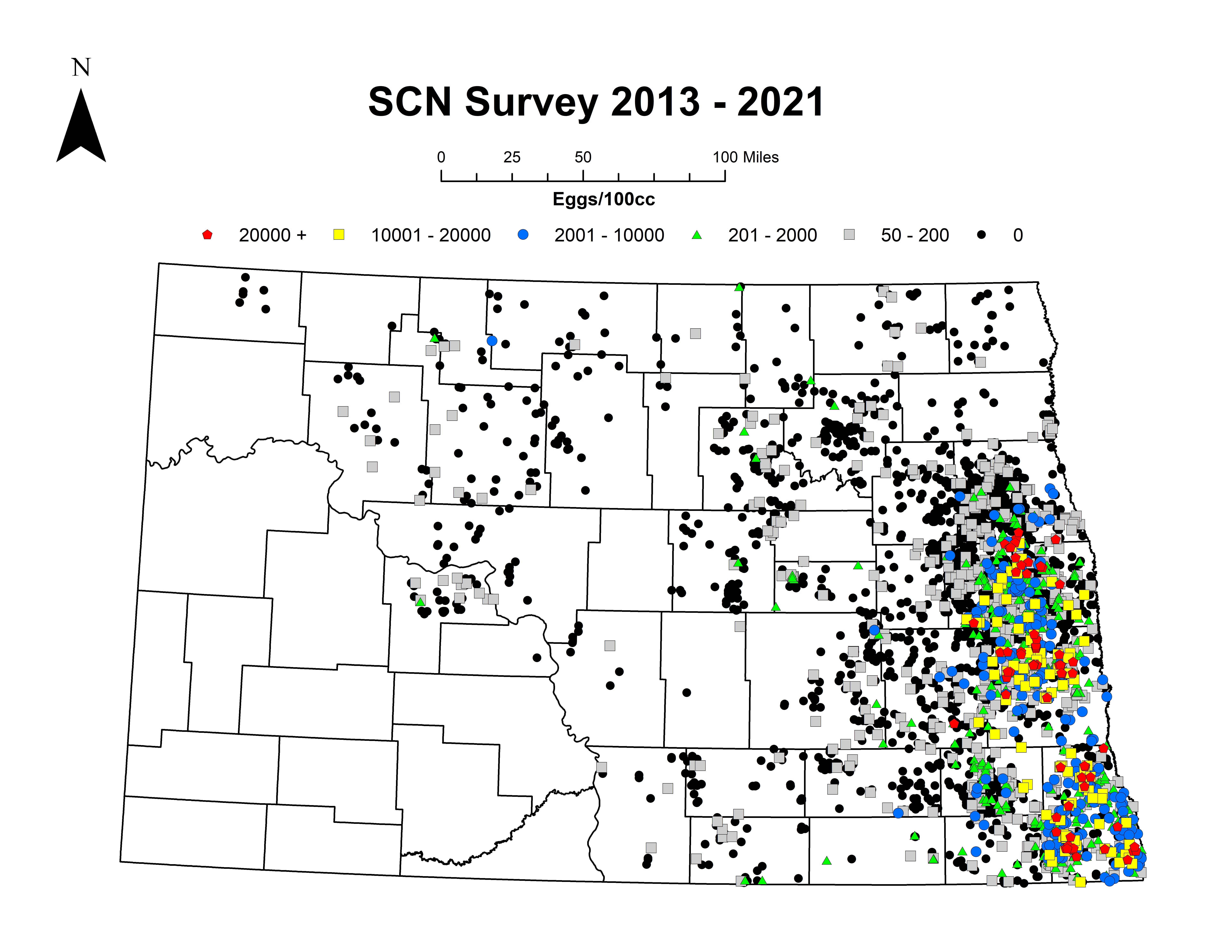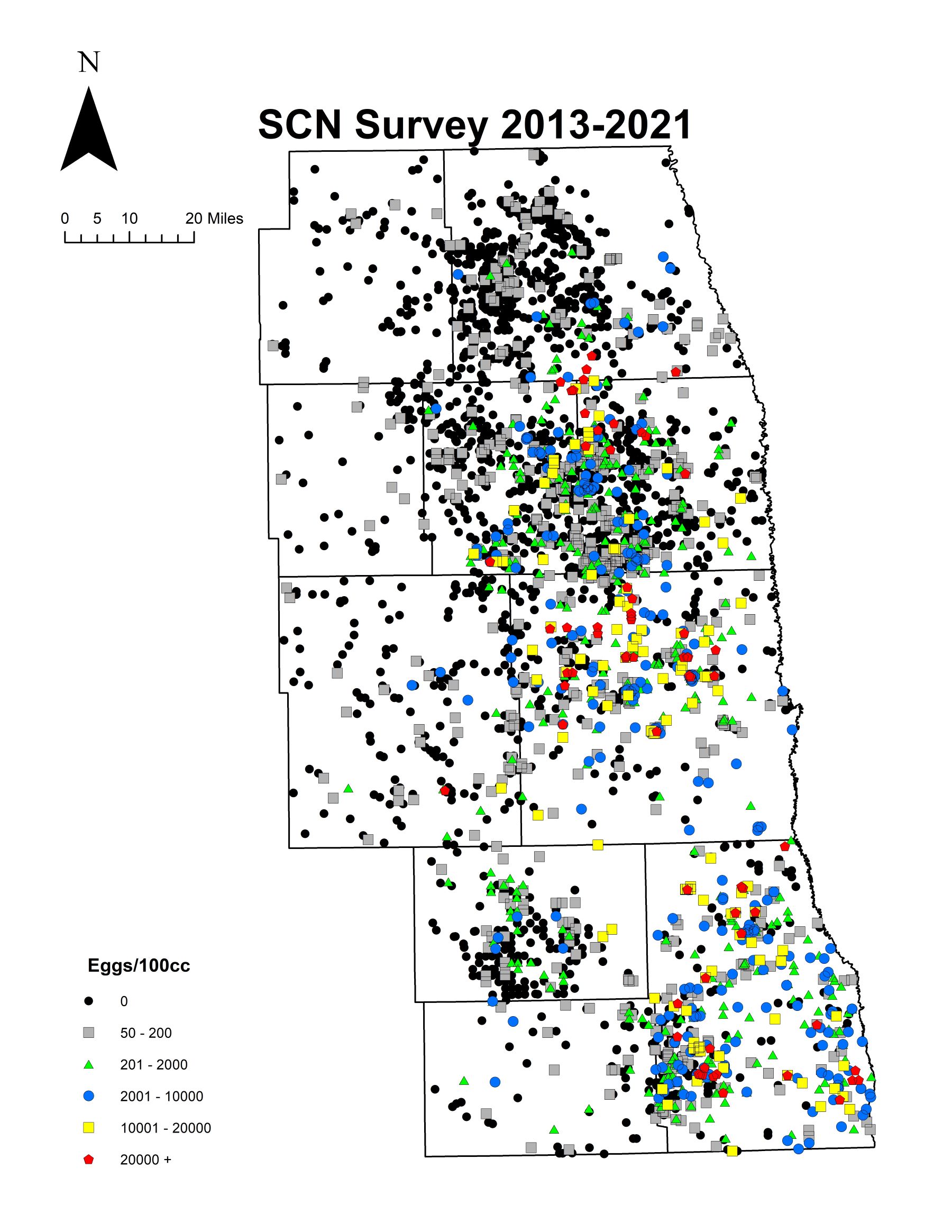Summary of Soybean Cyst Nematode Survey: 2013-2021 (05/19/22)
Between 2013 and 2021, approximately 4700 SCN soil samples have been submitted by North Dakota growers using the Soybean Cyst Nematode (SCN) sampling program supported by the North Dakota Soybean Council and operated by NDSU Extension (Figure 1). The North Dakota Soybean Council has financially supported the SCN sampling program by covering the cost of the laboratory fees when growers used pre-marked bags, which are available at the County Extension Offices in the fall. This program will continue in 2022 this fall. We thank the NDSC for their support!


What is SCN?
SCN is a nematode, a microscopic worm, that feeds and reproduces on root tissue. SCN is the top yield-robbing pest of soybeans in the US, causing over $1B in losses every year to the national soybean crop. SCN is notorious for causing yield loss before above-ground symptoms appear, making it difficult to detect. Consequently, soil sampling is the best way to detect SCN.
Where is SCN in ND?
Results of the statewide sampling program indicate the SCN is common in soybean fields is most frequently identified in the Southeastern and East central part of North Dakota (Figure 1 and 2). Test results show egg levels in additional counties, but they are less frequently identified and in lower numbers.
How do I interpret the numbers?
When a soil sampling is submitted for SCN, scientists microscopically evaluate the soil for nematode eggs, and present that number as eggs/100 cc soil (basically, how many eggs occur in about 3.3 ounces of soil). It’s not always easy to identify and count eggs (there can be false negatives and positives both), and sampling has its own variability, so interpretation of results is important.
In our maps:
- Black circles are negatives. It doesn’t mean you don’t have SCN for sure, but no eggs were found in a sample.
- Gray boxes (50-200 eggs/100cc) are very low levels, which could be real, or could be false positives (other nematodes produce eggs in soil too). I often suggest these are ‘inconclusive’, but it is critical you sample for SCN in the future.
- Green triangles (200-2,000 eggs/100cc) are low-level positives.
- Blue circles (2,001-10,000 eggs/100cc) are positives.
- Yellow squares (10,000-20,000 eggs/100cc) indicate high levels of SCN.
- Red pentagons (20,000+ eggs/100cc) are extremely high levels of SCN.
Yield loss becomes more likely as egg levels increase, but it is notable that yield loss is possible at any level of SCN. Why? First, SCN can reproduce very fast and numbers can go from 1,000 eggs/cc to 30,000 eggs/cc on a susceptible variety when the environment is favorable. Second, SCN is notoriously variable in fields and farms, and you will have both lower and higher spots in your field. The take home message? If you have SCN at any level, it is very important to manage it.
What can I do?
If you don’t know if you have SCN, sampling for SCN is the first and most important step towards management. This can be done in the spring (see the press release from The SCN Coalition) or most commonly in the fall. The NDSC and NDSU Extension are again supporting the SCN sampling program this fall, and more information will be available in future Crop & Pest Reports.
If you know you have SCN, sampling can be a great way to determine if your management tools are working. If you see your egg levels staying the same or dropping, you management tools are likely working. If those levels rise, you may consider adjusting the way you are managing SCN.
Where can I get more information?
NDSU Extension published a new ‘Soybean Cyst Nematode (SCN) management guide in April (2022), available mobile friendly (https://www.ndsu.edu/agriculture/extension/publications/soybean-cyst-nematode) and in original publication form (https://www.ndsu.edu/agriculture/sites/default/files/2022-04/pp1732.pdf)
The SCN Coalition (www.thescncoalition.com) is the website of a public-private partnership whose objective is the manage SCN. The website is full of resources, videos and more.
Extension Plant Pathologist, Broad-leaf Crops